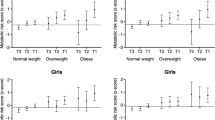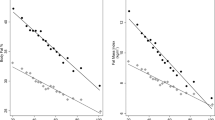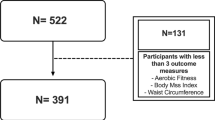Abstract
Background/objectives
Physical activity (PA) guidelines advocate that children should accumulate at least 60 min of moderate-to-vigorous PA daily. Still, it is not clear how body fat may differ if the same dose of PA is accumulated at different intensities. We aimed to determine the independent associations of energy expenditure (EE) at moderate (MPA) and vigorous (VPA) PA intensity on total and abdominal fat in children and if these associations were moderated by cardiorespiratory fitness (CRF).
Subjects/methods
A total of 326 children (girls = 171, boys = 151) aged 10–12 years had PA assessed with accelerometers. Total fat mass index (FMI) and abdominal FMI were assessed with DXA. CRF was assessed by a cycle ergometer test. Linear regression models were used to model the outcomes with the inclusion of an interaction term to test for moderation effects.
Results
An inverse association was found between VPA EE and FMI (β = −0.013, p < 0.001) and abdominal FMI (β = −0.0014, p < 0.001) independent of MPA EE. In contrast, MPA EE was not related to adiposity independent of VPA EE (p > 0.05). The relationships between the PA intensities and FMI and abdominal FMI were moderated by CRF. MPA EE was positively associated with adiposity in children with high levels of CRF, whereas VPA EE remained inversely associated with adiposity regardless of CRF level, although the strength of the association was lower in those with higher CRF levels.
Conclusion
PA programs should provide opportunities for children to perform VPA in order to achieve healthier body fat profiles and avoid excess adiposity.
This is a preview of subscription content, access via your institution
Access options
Subscribe to this journal
Receive 12 print issues and online access
$259.00 per year
only $21.58 per issue
Buy this article
- Purchase on Springer Link
- Instant access to full article PDF
Prices may be subject to local taxes which are calculated during checkout

Similar content being viewed by others
Data availability
Data are available from the corresponding author upon reasonable request.
References
Gishti O, Gaillard R, Durmus B, Abrahamse M, van der Beek EM, Hofman A, et al. BMI, total and abdominal fat distribution, and cardiovascular risk factors in school-age children. Pediatr Res. 2015;77:710–8.
Janssen I, Katzmarzyk PT, Srinivasan SR, Chen W, Malina RM, Bouchard C, et al. Combined influence of body mass index and waist circumference on coronary artery disease risk factors among children and adolescents. Pediatrics. 2005;115:1623–30.
Horesh A, Tsur AM, Bardugo A, Twig G. Adolescent and childhood obesity and excess morbidity and mortality in young adulthood—a systematic review. Curr Obes Rep. 2021;10:301–10.
Wyszyńska J, Ring-Dimitriou S, Thivel D, Weghuber D, Hadjipanayis A, Grossman Z, et al. Physical activity in the prevention of childhood obesity: the position of the European Childhood Obesity Group and the European Academy of Pediatrics. Front Pediatr. 2020;8:535705.
Bull FC, Al-Ansari SS, Biddle S, Borodulin K, Buman MP, Cardon G, et al. World Health Organization 2020 guidelines on physical activity and sedentary behaviour. Br J Sports Med. 2020;54:1451–62.
Gralla MH, McDonald SM, Breneman C, Beets MW, Moore JB. Associations of objectively measured vigorous physical activity with body composition, cardiorespiratory fitness, and cardiometabolic health in youth: a review. Am J Lifestyle Med. 2019;13:61–97.
Owens S, Galloway R, Gutin B. The case for vigorous physical activity in youth. Am J Lifestyle Med. 2017;11:96–115.
Janssen I, Ross R. Vigorous intensity physical activity is related to the metabolic syndrome independent of the physical activity dose. Int J Epidemiol. 2012;41:1132–40.
España-Romero V, Ortega FB, Ruiz JR, Artero EG, Martínez-Gómez D, Vicente-Rodriguez G, et al. Role of cardiorespiratory fitness on the association between physical activity and abdominal fat content in adolescents: the HELENA study. Int J Sports Med. 2010;31:679–82.
World Medical Association. World Medical Association Declaration of Helsinki. Ethical principles for medical research involving human subjects. Bull World Health Organ. 2001;79:373–4.
Freedson P, Pober D, Janz KF. Calibration of accelerometer output for children. Med Sci Sport Exer. 2005;37:S523–S30.
Troiano RP, Berrigan D, Dodd KW, Masse LC, Tilert T, McDowell M. Physical activity in the United States measured by accelerometer. Med Sci Sports Exerc. 2008;40:181–8.
Evenson KR, Catellier DJ, Gill K, Ondrak KS, McMurray RG. Calibration of two objective measures of physical activity for children. J Sports Sci. 2008;26:1557–65.
Hansen HS, Froberg K, Nielsen JR, Hyldebrandt N. A new approach to assessing maximal aerobic power in children: the Odense School Child Study. Eur J Appl Physiol Occup Physiol. 1989;58:618–24.
Muscella A, Stefàno E, Lunetti P, Capobianco L, Marsigliante S. The regulation of fat metabolism during aerobic exercise. Biomolecules. 2020;10:1699.
Boutcher SH. High-intensity intermittent exercise and fat loss. J Obes. 2011;2011:868305.
Pedersen BK. Muscle as a secretory organ. Compr Physiol. 2013;3:1337–62.
Pedersen BK. The anti-inflammatory effect of exercise: its role in diabetes and cardiovascular disease control. Essays Biochem. 2006;42:105–17.
Zouhal H, Lemoine-Morel S, Mathieu ME, Casazza GA, Jabbour G. Catecholamines and obesity: effects of exercise and training. Sports Med. 2013;43:591–600.
Poitras VJ, Gray CE, Borghese MM, Carson V, Chaput JP, Janssen I, et al. Systematic review of the relationships between objectively measured physical activity and health indicators in school-aged children and youth. Appl Physiol Nutr Metab. 2016;41:S197–S239.
Ortega FB, Ruiz JR, Hurtig-Wennlof A, Vicente-Rodriguez G, Rizzo NS, Castillo MJ, et al. Cardiovascular fitness modifies the associations between physical activity and abdominal adiposity in children and adolescents: the European Youth Heart Study. Brit J Sport Med. 2010;44:256–62.
Espana-Romero V, Ortega FB, Ruiz JR, Artero EG, Martinez-Gomez D, Vicente-Rodriguez G, et al. Role of cardiorespiratory fitness on the association between physical activity and abdominal fat content in adolescents: The HELENA Study. Int J Sports Med. 2010;31:679–82.
Migueles JH, Cadenas-Sanchez C, Ekelund U, Delisle Nystrom C, Mora-Gonzalez J, Lof M, et al. Accelerometer data collection and processing criteria to assess physical activity and other outcomes: a systematic review and practical considerations. Sports Med. 2017;47:1821–45.
Eddolls WTB, McNarry MA, Stratton G, Winn CON, Mackintosh KA. High-intensity interval training interventions in children and adolescents: a systematic review. Sports Med. 2017;47:2363–74.
Collins H, Fawkner S, Booth JN, Duncan A. The effect of resistance training interventions on weight status in youth: a meta-analysis. Sports Med Open. 2018;4:41.
Martin R, Murtagh EM. Effect of active lessons on physical activity, academic, and health outcomes: a systematic review. Res Q Exerc Sport. 2017;88:149–68.
Callender LK, Borghese MM, Janssen I. Which intensities, types, and patterns of movement behaviors are most strongly associated with cardiometabolic risk factors among children? J Sports Health Sci. 2021;10:368–78.
Acknowledgements
We would like to express our gratitude to the participants for their contribution to the present investigation.
Funding
This investigation was conducted at Interdisciplinary Center of the Study of Human Performance (CIPER), Faculty of Human Kinetics of University of Lisbon, and supported by fellowships from the Portuguese Foundation for Science and Technology (Grant number: PTDC/DES/108372/2008).
Author information
Authors and Affiliations
Contributions
LBS conceived and planned the experiments. DAS carried out the experiments and data collection. JPM, DAS, and MH-R did the data analysis. LBS, JPM, DAS, and MH-R contributed to the interpretation of the results. LBS and MH-R took the lead in writing the manuscript. All authors provided critical feedback and helped shape the research, analysis, and manuscript.
Corresponding author
Ethics declarations
Competing interests
The authors declare no competing interests.
Ethics approval and consent to participate
The research protocol was approved by the Portuguese Ministry of Education and all participants, and their parents or legal guardians provided written informed consent prior to their participation and in accordance with the World Medical Association’s Declaration of Helsinki on human studies.
Additional information
Publisher’s note Springer Nature remains neutral with regard to jurisdictional claims in published maps and institutional affiliations.
Rights and permissions
Springer Nature or its licensor (e.g. a society or other partner) holds exclusive rights to this article under a publishing agreement with the author(s) or other rightsholder(s); author self-archiving of the accepted manuscript version of this article is solely governed by the terms of such publishing agreement and applicable law.
About this article
Cite this article
Sardinha, L.B., Magalhães, J.P., Santos, D.A. et al. Intensity matters: impact of physical activity energy expenditure at moderate and vigorous intensity on total and abdominal obesity in children. Eur J Clin Nutr 77, 546–550 (2023). https://doi.org/10.1038/s41430-022-01242-y
Received:
Revised:
Accepted:
Published:
Issue Date:
DOI: https://doi.org/10.1038/s41430-022-01242-y
This article is cited by
-
Challenges in measuring energy balance and body composition
European Journal of Clinical Nutrition (2023)



